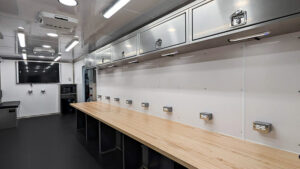A quality upfit doesn’t happen overnight. Planning for your next vehicle upfit can be a complicated process if it is rushed or unorganized. There is a tremendous amount of consideration and work that is required when making your vehicle service-ready, but if done effectively, it can improve your team’s productivity, efficiency, and safety.
Here are four strategies to improve your upfit process this year:
1) Plan Ahead
Properly planning in advance can minimize errors and help the upfit process run more smoothly. It is important to take in account how long it is going to take to spec your vehicle, acquire price quotes, the ordering process from different vendors, production times, to delivery. What you can do to get a head start is determine:
- What worked well last year and what could be improved this year?
- A list of your department’s vehicle needs/wants?
- What make, year, and model of vehicles you plan to purchase for the year?
- Will you be purchasing the newest vehicle model or previous one? If new, consider how long will it take for the vehicle to be delivered.
- What equipment do you have and what do you need to purchase?
- Who will complete the installation? Does it need to go to bid?
- A projected timeframe for when the vehicles needs to be in service.
The earlier you start planning and determine the cost of your ideal upfit, the sooner you can secure your budget, vehicle specs and delivery time.
2) Involve End Users
Fleet managers know a lot about their fleet and how the team works. However, involving the end-users in the upfitting process will help streamline the process and come up with ideas you many not have thought of. Ask your drivers, mechanics, and technicians for input on the following:
- To improve safety and efficiency on the job, what equipment is needed?
- Review vehicle specs and get their opinion on their operational needs.
- Review upfitting components to ensure all tools and equipment are included to perform their job.
- How can you standardize the vehicles?
A complete understanding of the team’s requirements and input allows for the planning to be done right and have 100% buy-in from all users.
3) Don’t Focus Solely on Price and Location
Oftentimes, fleet managers make their selections based on lowest price or closest location to their facility. This isn’t always the safest option. Understanding your budget and costs are important to consider, but it shouldn’t be the determining factor when selecting a vendor. When making selections, think outside the limits of price and location. Some attributes aside from location and price that should be considered when choosing your suppliers/upfitters are:
- Quality of product/workmanship: Do you know anyone that has used the product before? If not, ask for a couple references and call them to get their opinions on what they like and don’t like to determine if it is the right solution for your team.
- Dependability/reputation: Can you count on the vendor to meet your timelines and budget? Do they have a good reputation in the industry? Check out their website and reviews online.
- Experience and vendor relationships: Choose a vendor that you can trust and most importantly you can count on. The last thing you want is to place an order from a vendor and it’s impossible to get an update.
- Delivery Times: Make sure the vendor is aware on the expected delivery times and ensure it is achievable.
4) Limit the Use of Vendors
Many fleet managers allow for too many vendors when upfitting their vehicles. This results in waiting for supplies/product to be delivered at different times, delaying the completion of the vehicle. Selecting minimal vendors can save you time and money and minimize the risk of errors due to miscommunication or misinterpreted expectations/specifications.
There is an abundance of options for vehicle upfitting which is why the process can be tedious and challenging. Starting with proper planning, receiving end-user input, finding quality suppliers/upfitters and standardizing wherever possible will help to improve your process, and save you time and money.

